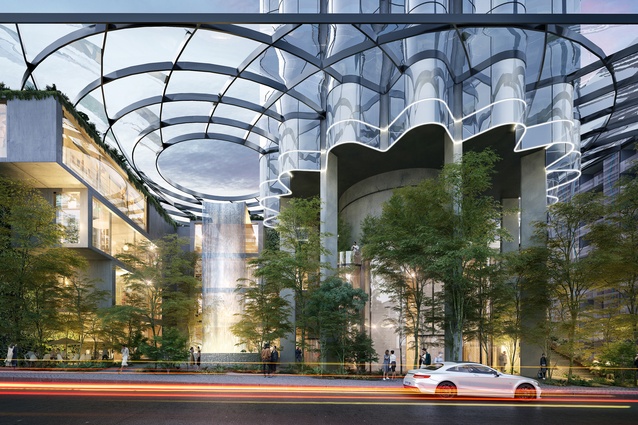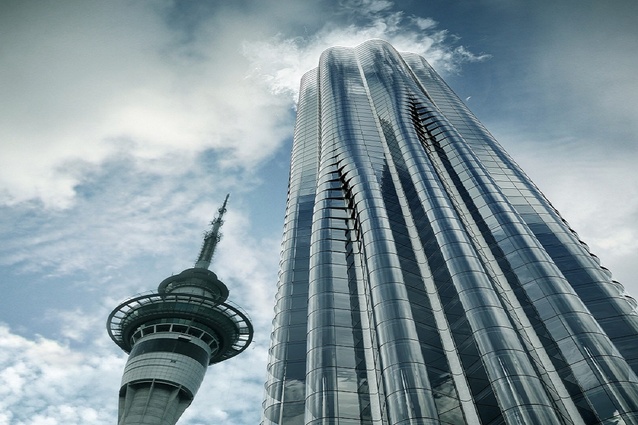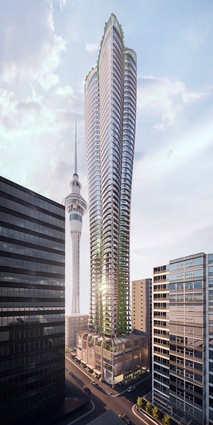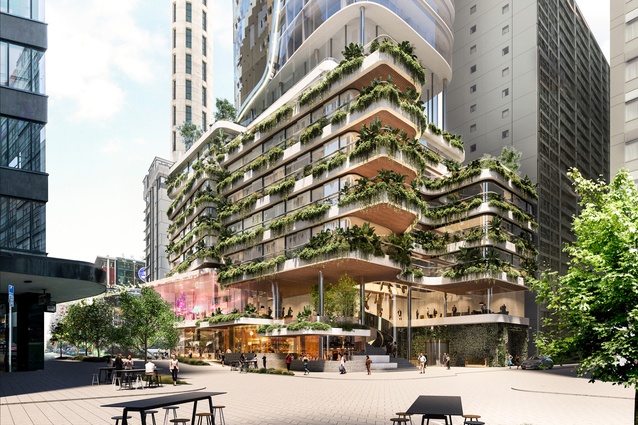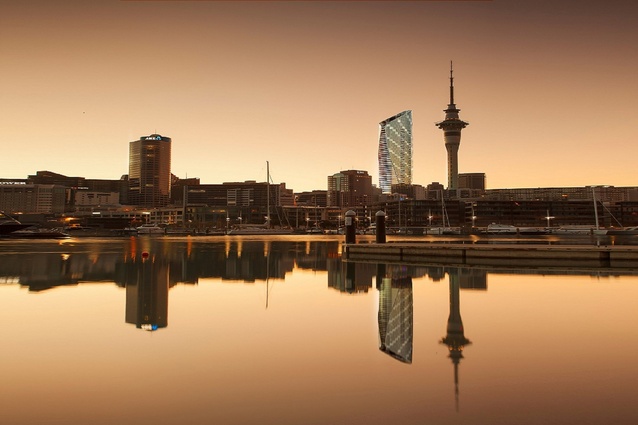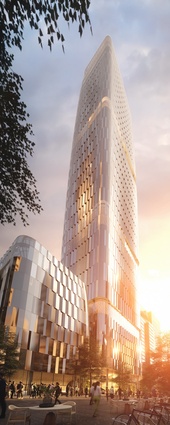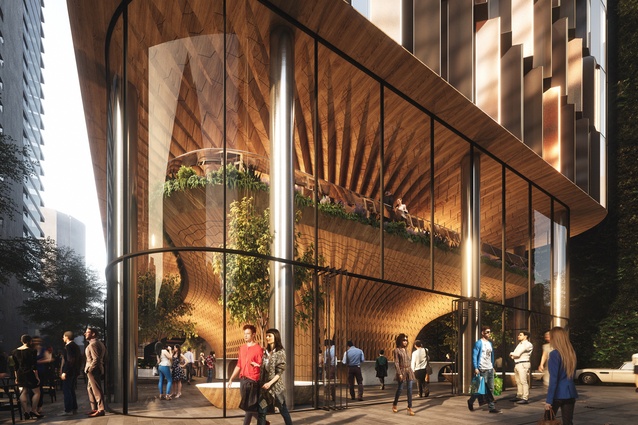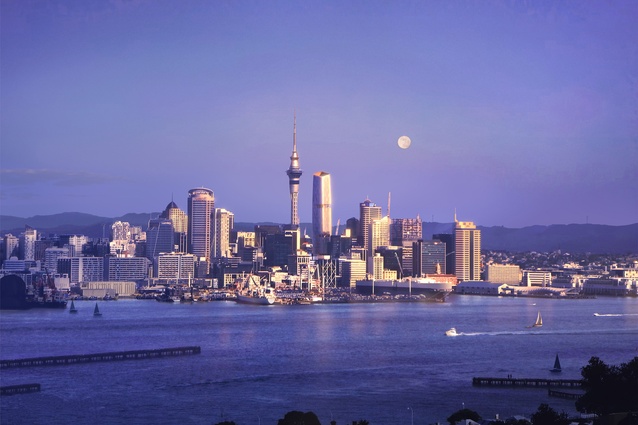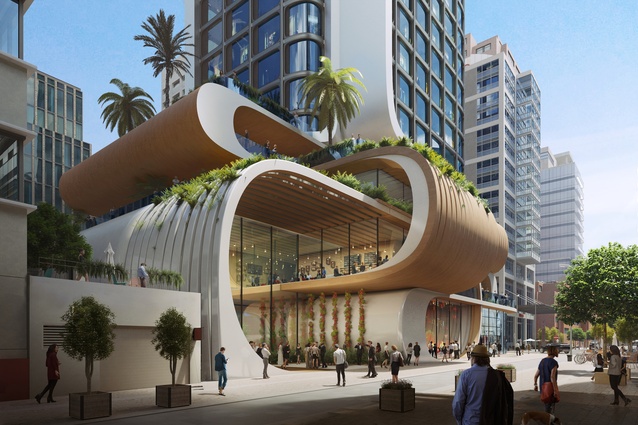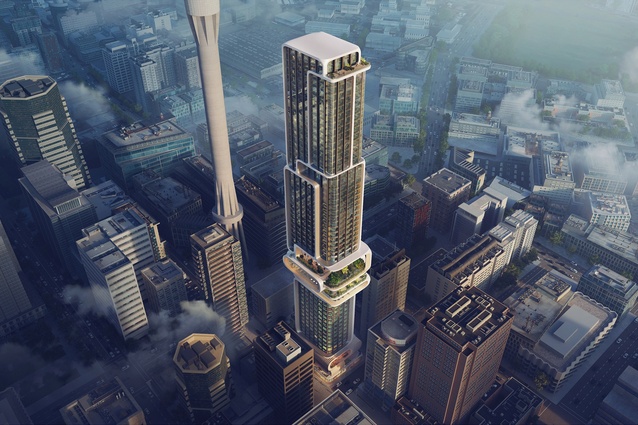A tale of five towers: 65 Federal Street
Melanie McDaid shares her thoughts on the recent proposals for 65 Federal Street from five of the world’s top architecture firms.
McDaid is the founder of design firm Sloane & Peach and has been in the architecture industry for over 15 years. She has worked extensively on London regeneration projects with PDP London including a high profile, $900m (NZD) landmark tower scheme at design stage, which maximised and released a key site in central London.
Re-watch the presentations from each of the five architecture firms here.
North America and Scandinavia do it best, apparently. Cities, that is, according to David Kidd of WSP at “What’s Next Auckland?”, an event that showcased designs from five of the world’s best architects for a new, mixed-use tower at 65 Federal Street. The event doubled as a forum to discuss the future of Auckland’s skyline and development of the city.
Those North American and Scandinavian cites that do it best are Seattle, Copenhagen, Stockholm, New York and Vancouver, the top five of the WSP Global Cities Index. They rank at the top because they are set up to meet the challenges, demands and opportunities that the future will bring, so says A Tale of 30 Cities, a report by WSP. The report puts Auckland at 13th place, punching above its weight for a city of its size.
Unsurprisingly, The City of Sails falls short on housing availability, road dependency, water infrastructure, power generation and the sustainability of that power generation. Interestingly, given the investments in infrastructure presently being made in Auckland, Kidd emphasised the importance of long term planning in building a great global city.
Australia’s ICD Property is the developer behind the tower at 65 Federal Street, and they have decided to invest, a lot, in New Zealand’s largest city. The ability to attract international investment demonstrates how Auckland is already a leading global city. This is further reflected in how the central city is fast becoming more than merely a business district, which only bustles during the week and in the evenings, but also a place for people to live.
In July, the developers launched a competition, inviting five of the world’s leading architectural firms – London-based architects Zaha Hadid, local architects Warren and Mahoney, and international firms Woods Bagot, Cox Architecture, and Elenberg Fraser – to create a skyline symbol to house hotel and apartment living at 65 Federal St.
The brief to the architects was that the tower must enhance the Auckland skyline, refresh and enliven Federal St and the surrounding streets and reinforce Auckland as a truly global city with a design that reflects the unique fabric of the city. Ideally, the $200m tower would also tell a powerful and marketable story connected to people and place.
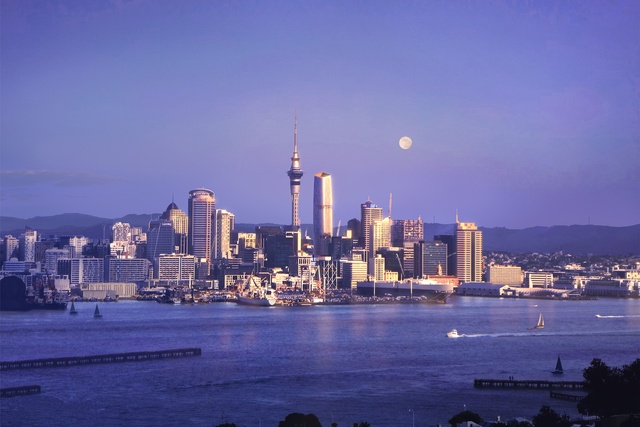
Competitions are tough work. Having worked on a project with similar time frames and design intentions in central London recently, I can tell you from experience that all the schemes showed incredible commitment from the architects. I think the hotel brief is particularly challenging. Hotels can have the effect of deactivating the street in such a damaging way.
It is tempting to fall into the trap of focussing too narrowly on the practicalities of operating the hotel, placing the building on a set back and having large porte-cochere’s facing the street. However, the result is a car park at street level and an unmonitored, unsafe, hostile pedestrian crossing. The key for a development like this is to activate and enliven the street. This is a very hard thing to do, and often you need to rely on commercial, semi-public spaces like cafés, restaurants and cultural spaces, which intrinsically do this well.
High-rise architecture provides both challenges and opportunities. The scale means that design identity can be expressed both at the ground plane and at the skyline. How the entries meet the ground and how they reach for the sky are the two main ways that most people will experience this development.
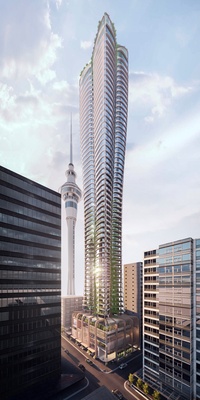
All of the designs used podiums to anchor the landmark buildings to the street. Putting aside the skyline statements, none of the entries totally succeeded yet at street level; in this early stage that is to be expected, and the architects know there is more work to do in that respect.
Phil Rowe of Cox Architecture, who teamed up with local consultancy firm WSP Opus, said the challenge posed by ICD’s project was to address how architects and designers can improve and inspire the city’s future. “It has to be done in a very Auckland way, rather than importing what is perceived by fashion to be ‘best practice’. The building will be a visual icon for what Auckland can and will look like in the future.”
Much was discussed about the importance of residential amenity and having a ‘New York’ state of mind when it came to doing residential living well; there was talk of amenities such as a concierge and doormen. Cox Architecture discussed their aim of allowing their development to improve the first 20 storeys of building for the pedestrian. Therefore, the proposed tower creates larger floor plates above the 20-storey mark, giving a bigger mass at the skyline.
Of their entry, Rowe said, “The fundamentals will be expressed for all to see on a city skyline where ‘sky homes’ and unique amenity, for both residents and a wider community, can excite Auckland about a bright future of city-dwelling, specifically relevant to the way Auckland lives, works and plays. These are all key elements that describe a project of true legacy, as opposed to one which is cookie-cutter, purely for profit.”
In his architect’s statement, Elenberg Fraser’s Callum Fraser said, “This is a real opportunity to see what the future looks like.” Fraser started his presentation with an image of Mies Van der Rohe’s Neue Nationalgalerie in Berlin. The New National Gallery was constructed in the aftermath of the Second World War and was created as (according to Fraser) “an urban panorama room – a glass box that sits on a plinth so large that, from the interior, the horizon merges with the ground plane”.
This seemed to be the starting point for their design and the driver behind their main idea of evacuating the ground plane and reinstating the traditional forests of New Zealand. Fraser also had strong views on Auckland’s existing Sky Tower. “In the future it will be one part of a bustling skyline; the Sky Tower is not the Sagrada Familia. It’s not a religious icon which requires its own clear space in the city skyline,” he said.
As the basis of their conceptual work, Fraser spoke several times throughout his presentation about New Zealand indigenous architect Rewi Thompson. This connection seemed to lend Elenberg Fraser a greater understanding of our local culture and, as a result, their design felt like a well-conceptualised response.
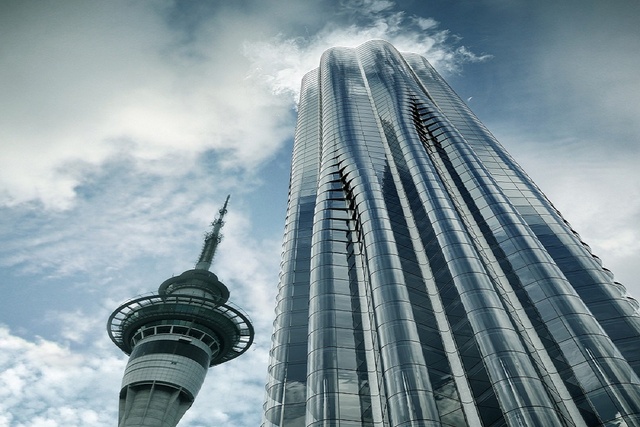
Fraser sums up the stunning, fantastical entry (created in collaboration with local firm Jasmax) in their proposal. He says, “We have proposed a tower that reflects Auckland’s dramatic location atop 48 volcanoes. At the heart of the forest is a well, where the rushing water cascades from above and crashes into an underground grotto below. The architecture is driven by the desire for each room to have a huge, curved bay window so that occupants can sit directly into the view lines of the urban geography.
“This is the building that we have been learning for our whole lives to achieve, a moment in time that changes everything that will come after it, the kind of building that Auckland deserves.”
New Zealand firm Warren and Mahoney demonstrated their nuanced understanding of the site, city and concept. Their entry is inspired by a korowai (Māori cloak) and was tag lined by them as “texture at the base, symbol in the sky – the enduring symbol of the korowai: dignity, gravitas and enduring mana”. The concept can be read, quite literally, on the building’s cascading façade.
Warren and Mahoney principal architect Andrew Barclay presented the design and said the Federal Street project is an opportunity to reflect Auckland’s unique population, cultural diversity and geography. “At present, Auckland does not have a mixed-use hotel and residential building that has these qualities,” he said.
“The project is located in one of Auckland’s most exciting locations, so it has a responsibility to contribute to Auckland’s increasingly vibrant inner-city life, both during the day and by night.”
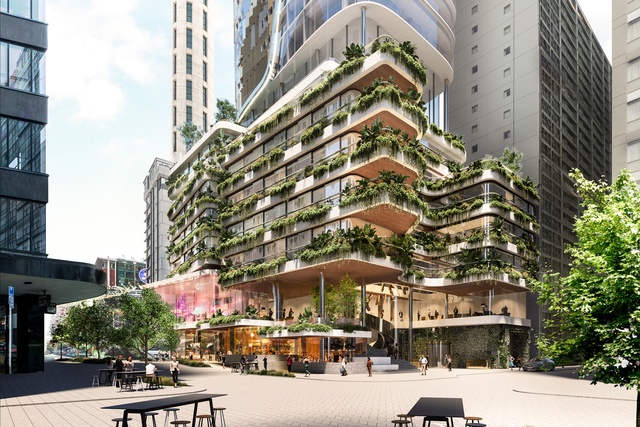
The Warren and Mahoney scheme did capture a Kiwi identity, and it was clear they did not need to labour over a search for a New Zealand meaning; they understood the essential characteristics that make something speak of our city.
Global architecture and design studio, Woods Bagot teamed up with local architects Peddle Thorp for their entry. Their concept, which was imagined as a formation rising from Auckland’s natural environment, alluded to Auckland’s geology, local flora and fauna. Because of this, they say their tower, with its dynamic façade, could not exist anywhere else in the world.
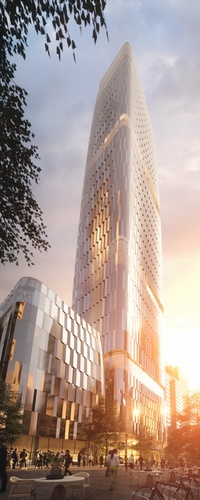
“Sightlines to culturally significant landmarks, the height of the streetscape, pedestrian connectivity to key destinations and Auckland’s weather have all been carefully considered in order to create a structure that could only sit within this particular skyline” Pete Miglis, principal architect at Woods Bagot, explains. The proposed project will include a publicly accessible roof plaza, complete with a hotel lobby as well as a rooftop cinema, bar, and lounge.
Woods Bagot felt the street “needed help” and envisaged the opportunity for pedestrian laneways to run the north/south axis through the site and connecting to the water. “The new building encourages movement through and into the site as a more civic gesture – exploring the potential as a central part of what could become a green laneway that is pedestrian and bike-focused.”
On deciding whether to compete in the competition, Zaha Hadid Architects’ associate director Michele Pasca di Magliano said, “It took us five minutes to decide if we were going to do it.” He spoke of their iconic architecture and recognisable landmarks and their ability to “accelerate performance of the cities where these buildings are inserted”. Inserted was an interesting choice of words given it connotes an absence of connection or context. However, happily, he did recognise the importance of exclusivity by posing the question, “Can we create something that cannot be built anywhere else?”
It’s tempting to want a building designed by Zaha Hadid Architects for Auckland for its pulling power and potential to create a worldwide recognisable landmark. If this project is (and it may not be) one that stands as a symbol of Auckland’s progress on the international stage, then arguably no entry can deliver as spectacularly as them.
Zaha Hadid Architects also teamed up with local firm WSP Opus and their design was inspired by bringing the city’s streetscape into the very heart of the tower with a Sky Garden.
“Auckland’s ambition and vision for the future must cater for everyone in the city. In that respect, mixed-use projects with plenty of publicly accessible spaces will be the most successful,” said Pasca di Magliano. “Auckland has a great opportunity to re-engage with its architecture and enhance its urbanism for the people of the city” he said.
Their complex design, which took its first form from the influence of the Māori Pouwhenua (land posts), has a hefty 54 storeys and aims to activate the street with restaurants, cafes, art spaces and other commercial elements. The tower element is broken up in its verticality with what Pasca di Magliano describes as ‘horizontal transitional moments’.
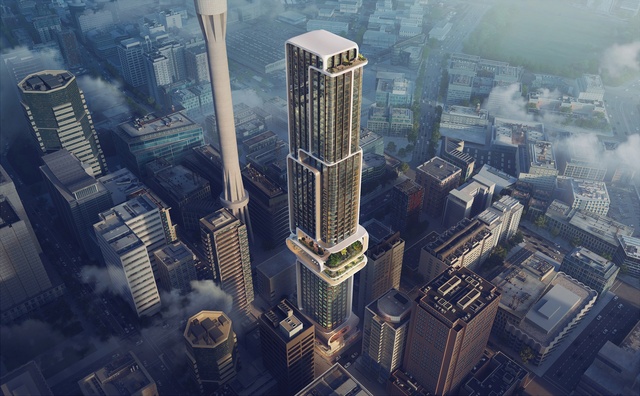
When David Kidd opened the evening, he mentioned how important tall building design was, as in the last hundred years he only knew of four skyscrapers that were taken down in a planned way. I think that puts into perspective how significant the careful development of a bustling sky scene is for Auckland.
It is early days for the design of the new tall tower at 65 Federal street. Having watched the brief presentations given on the night, I’m particularly intrigued by the Elenberg Fraser and Warren and Mahoney schemes, for the strong cohesion between their early conceptual ideas (which both felt very genuine) and their impressive, honest initial designs.
However, there were delightful moments within each of the entries, Woods Bagot’s dynamic façade and split podium, for example. In progressing with the scheme, I think it will be hard to choose one to move forward. I suspect the judges may be tempted to shortlist further. ICD will take ownership of the site in April 2019 and construction is expected to complete in 2022.
Attending the evening and having been presented these schemes has confirmed to me that Auckland is in fact coming of age. In an increasingly threatened, tense and standardised world, a unique, diverse, relatively ethical, anti-corrupt and adventurous Auckland will fast become a desirable target for investment as the world looks to New Zealand for solace.
Over the next few years several major projects will be completed in central Auckland and many projects will start to be envisaged that will allow both visitors and people who call this city home to come together. People are watching to see what all this means for the new built environment of Auckland city which is rapidly being constructed and needs to be considered with our special culture in mind.
What kind of city will we become? As Phil Rowe from Cox Architecture so succinctly put it “Perhaps the most exciting thing is that all this global interest is clearly based on an appreciation of Auckland remaining Auckland, not tied to its past, but using its uniqueness and diversity as stimulus and impetus for growth – specifically growth in its own unique and authentic way”.
McDaid’s firm Sloane & Peach is a design practice that is quickly expanding into a collaborative, multimedia platform. It celebrates intelligent and genuine ‘places, spaces and objects’ while investigating and conversing on the important issues relating to the creative industries. Follow Sloane & Peach on Instagram here.

